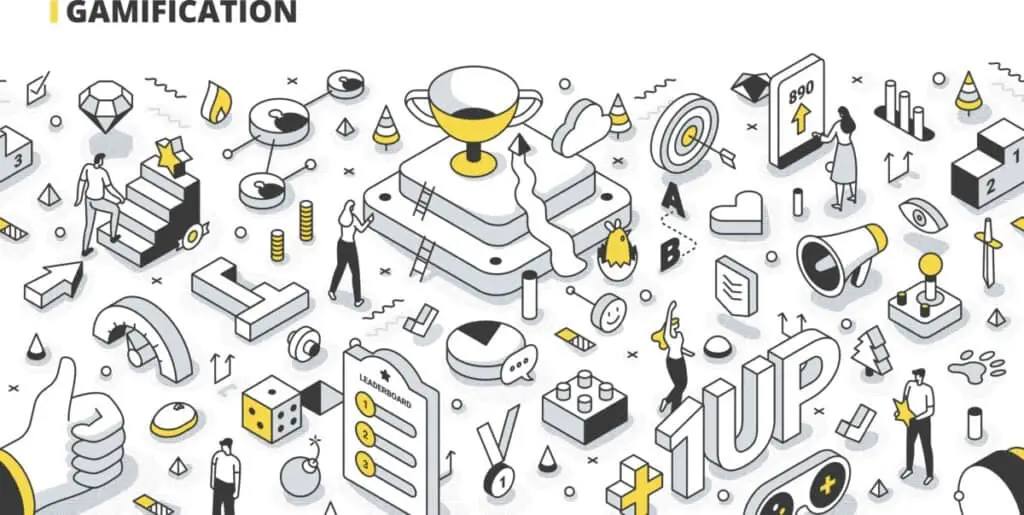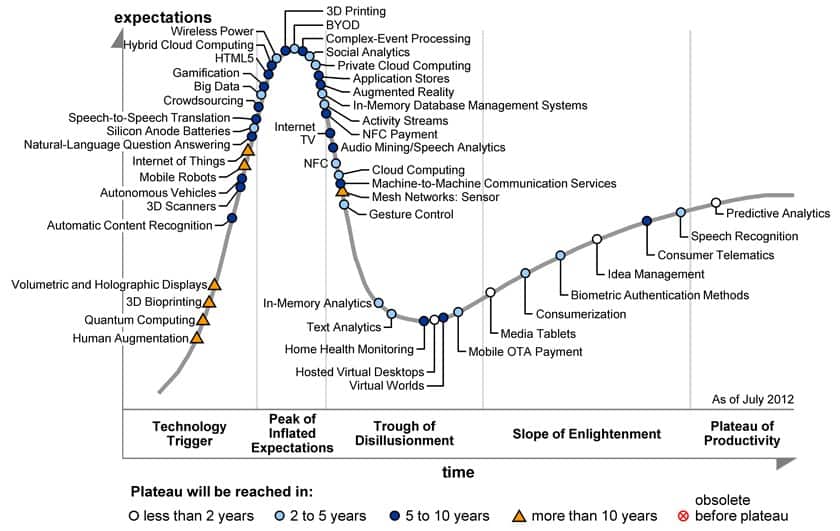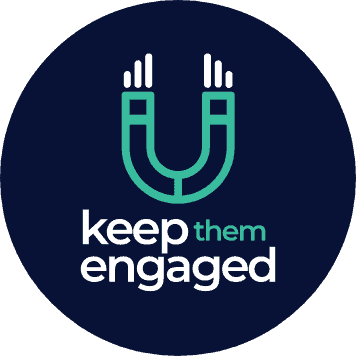
After intensely studying gamification I found that there are different opinions on what gamification is and what gamification is not.
Understanding what it is not can help create a good and successful gamification design that delivers results, so I went ahead and wrote you a summary of my research.
Gamification is not just a marketing tool
Increasing sales or brand awareness is definitely something that can be achieved using gamification concepts. However, gamification itself is not a strict marketing or sales tool.
Gamification is focusing on user engagement and motivation, which can certainly be used to create an amazing marketing story, which in turn could of course bring in more sales (in-depth article here).
Two really good examples of companies using gamification for marketing and sales purpose are Starbucks and The Coca-Cola Company.
In Starbuck’s loyalty program you receive incentives such as free food and drinks, plus a number of stars that can be redeemed to purchase prices or specific items.
If you have enough points you received a so-called gold member status with even more rewards plus some serious bragging rights and a sense of achievement. However, this was until late 2019 when they decided to redesign the loyalty program.
They removed the gold member status and made it possible for everyone to get additional items and such as spending a relatively low amount of money on purchases (more about this here).
My guess is that the barrier of reaching the gold member status in the previous program was perceived as too high, which can be demotivating for customers who are just casually considering signing up, leading to fewer customers joining the loyalty program.
The second example is as promised the genius Coca-Cola bottle with a twist which can only be opned by two people. They positioned it as a way for collegue freshmans to engage and “break the ice”, which of course let to a increase in sales for Coca-Cola and a really cool story for them.
By designing a coke bottle in a way that can only be opened with another bottle can be considered a group quest fostering social interactions, which is definitely a gamification design technique.
Good gamification is not easy to design
Okay straight up, creating good gamification is quite difficult. When gamification had its peak in 2013/2014 a big number of companies tried to use gamification concepts to help motivate their employees or engage with their customers.
Unfortunately, 80% of the gamification projects failed due to poor design and other factors involved which you can find in more depth here “Gamification is dead! Long live gamification.“.
If you want to use gamification to increase your engagement- or retention rate with your customers or internal employees, then I suggest to take a course about the subject before starting to design.
Gamification is not a simulation
A simulation is a controlled low-risk environment, where learners can practice specific behaviors with the purpose to experience the outcome of their actions.
Think of a flight simulator that provides pilots an exact feel for the cockpit and the respective controls to experiment and learn the skill of piloting an airplane.
Of course, being in an actual airplane with changing air pressure and the feeling of acceleration is another story but the controls and procedures can be learned while being in a controlled low-risk environment.
Gamification on the other hand focuses on the experience for the learner. It tries to make the act of learning more engaging, fun and motivating using game elements.
Gamification is not just using points, badges or leaderboards
The first applications I designed only focused on the most common gamification elements called points, badges, and leaderboards (in short PLBs).
I thought that this was how you can use gamification and as soon as people have some form of incentive such as gaining points or seeing yourself on top of a leaderboard they’re ready to just keep using my service.
I was so wrong. Gamification is so much more. The concept for starters touches upon several disciplines such as design-thinking, psychology and game theory.
For example, when designing gamification in a service there are specific techniques focusing on motivating a person by scaring the user that he or she will lose something, e.g. points, a reward, or their status.
Similar to when you were a child and miss behaved and got your GameBoy rights revoked.
This approach is used in many applications but should be for example used carefully because it can harm the engagement level in the long term and might actually lead to the user leaving due to the sustained level of frustration and the feeling of pressure to keep playing, which is overtime simply not fun.
Gamification is not a game
The most common misconception from business leaders is that, because the word gamification starts with “game”, it must be somehow a game but for a business purpose. Wrong, gamification is definitely not a game. The difference between a game and gamification is actually quite simple to understand.
| Games | Gamification |
| Games try to engage their players in a playful way to entertain them and to keep them in the game. | Gamification focuses on engaging players by making them experience and feel a strong emotion that focuses on motivating them to continue the service. |
| Games use elaborate story lines, intense graphics or animation to create a authentic and engaging experience. | Gamification does not usually have expensive animations or graphic elements to entertain users. |
| It is focused on enabling users to achieve their goals, and if the goals have meaning then the users become engaged on a more intense emotional level |
Gamification is not dead, it is growing rapidly
The gamification concept had an amazing time with almost every organization and professional claiming to incorporate gamification from 2011 – 2014. Even the famous Gartner Hype cycle showcasing the current status and its awareness in the industry listed Gamification as an emerging technology.

– Sudarshan Gopaladesikan
Until almost 80% of gamification failed due to poor designs and self-acclaimed experts who thought that putting points, leaderboards, and badges on any kind of application or service will automatically make a tedious task fun and engaging for their users or employees.
This high percentage of failed gamification projects and the expert dilemma are simple examples of why gamification lost immensely on interest during the past years.
People were in a sense feed up by the term and the promise it made which led to less interest and fame of gamification in the media and the industries. Making gamification appear as completely dead.
Nothing could be further from the truth. The Gamification industry is booming and according to the newest market research studies are projected to increase their current $7 billion market by more than 30% until 2025.
The reason for this is that if gamification is done right it can accomplish incredible engagement numbers.
More about this topic and why gamification has been declared dead, as well as why it certainly isn’t to provide a deeper insight on why it makes sense to learn more about gamification, can be found in this article here: “Gamification is dead! Long live gamification.“.
Gamification is not a learning game
This one is quite easy and simple to understand. A learning game can be considered an environment that has all the elements, features and essay requirements in place to teach a skill.
In addition, the learning game educates the learner in its environment by starting as a complete beginner in a skill. Who then to slowly increases his/her skills until they become an expert in the skill.
So if you would start in taking an excel course, the course would start in teaching you the basics of excel with its formulas. Then gradually introducing more advanced formulas and functions such as v-lookup, until the course teaches advances macro programming and such.
Gamification on the other hand tries to apply game mechanics to real life process to make the experience itself fun and engaging.
Gamification is not just applicable to one scenario
The concept of applying game elements, such as quests, teams, currency, and such to non-game context, is not just applicable to a single scenario. The methodology of gamification can be applied to a variety of different scenarios and industries, ranging from healthcare to retail, or even politics.
It is important to understand that gamification is a design methodology. This means that it can be altered, adjusted, and designed to fit any context. The only real requirement is that the gamification design is done in a proper way.
Gamification is not always ethical
This is something that needs to be considered every time you start considering applying gamification principles. In some cases it might simply not be ethical to employ certain gamification elements.
One of the pioneers in the gamification space is approaching it by considering if the person who is using the system is completely aware of the intent of the system and is the user aware of “signing-up” to the system.
- Is there full transparency on its intended purpose?
- Does the user implicitly or explicitly opt-in to the system?
He furthermore dives deeper and mentioned that if there is a hidden agenda that a potential user is not aware of then the use of gamification is utterly unethical.
Gamification is not game theory
A quite common mixup due to the related names. Game theory and gamification are however not the same things.
Game theory is in its simplest form focusing on the strategic decisions made by people or players and its respective result or outcome of that descicion.
So as an example, if you have a choice between three options, A, B, and C. And you choose B, then the study of game theory would analyze why you have chosen option B. Which factors lead you to that descicion and how are the other options influencing you and such.
Whereas gamification is focusing on applying game elements into non game related situations.

